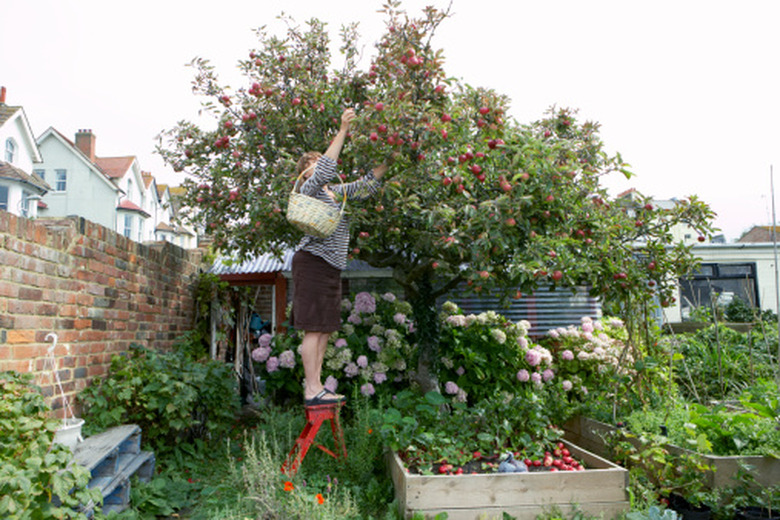Small Trees That Grow No Higher Than 14 Feet
Not everyone has the room to grow majestic trees on their property, but power lines, crowded landscapes and small plots don't have to be seen as limitations. They can also be seen as challenges. There are many smaller trees, usually categorized as semi-dwarf or dwarf, that offer everything you could desire of a tree in your landscape, except unmanageable size.
Japanese Cutleaf Maple
The Japanese cutleaf maple is a showy tree with either green leaves that turn yellow in the fall or purple leaves that stay predominantly purple. This cultivar grows no more than 8 feet tall and spreads out in a graceful umbrella shape reaching 10 to 12 feet across. American gardeners were first introduced to the Japanese maple by Dr. George C. Hall, who also introduced Japanese honeysuckle. Cutleaf maples are slow growing and prefer a southern exposure with filtered afternoon shade, soil that drains well and even moisture. The Japanese cutleaf maple should be used as a focal plant without too many other trees or bushes planted nearby.
- Not everyone has the room to grow majestic trees on their property, but power lines, crowded landscapes and small plots don't have to be seen as limitations.
- The Japanese cutleaf maple is a showy tree with either green leaves that turn yellow in the fall or purple leaves that stay predominantly purple.
Crape Myrtle
Many varieties of crape myrtle are cultivated as dwarf and semi-dwarf trees. Many of these grow only tall enough to be considered shrubs, between 3 and 5 feet tall. There are several semi-dwarf varieties to choose from when the attributes of the classic crape myrtle tree are exactly what your landscape needs. The Zuni, Pecos, Pink Velour and Hopi varieties each grow between 8 and 12 feet high while providing abundant pink blossoms in spring and bright shades or orange and red foliage in the fall. Burgundy Cotton reaches 12 feet tall and offers white blossoms, but no fall color. For those who prefer a red-blooming crape, there is Centennial Spirit and Christiana, both of which grow 8 to 12 feet high and provide brilliant autumn hues.
Conifers
Conifers are evergreen trees that bear cones, such as a pine tree. Several varieties of conifer grow naturally under 14 feet tall. The Japanese umbrella pine called Joe Kozey is a pyramid-shaped upright conifer that reaches only about 6 feet tall. The needles of Joe Kozey have a rubbery texture and are bright yellow, especially when the tree is grown in its preferred shady environment. It is a slow growing tree that requires little care. Another benefit of the Joe Kozey is that it is deer resistant. The variegated elkhorn cedar is a conifer with a mounded shape and lacy, bright white and green needles. Elkhorn cedar reaches about 6 feet high and prefers a moist, somewhat shady spot.
- Many varieties of crape myrtle are cultivated as dwarf and semi-dwarf trees.
- The variegated elkhorn cedar is a conifer with a mounded shape and lacy, bright white and green needles.
Crop Trees
Fruit and nut trees are two of the most common types of tree that can be found growing under 14 feet, thanks to the popularity and the success of breeding miniature varieties. Dozens of varieties of apple, citrus, stone fruit and nut trees are available to the home gardener. The Starkspur Winesap apple grows between 8 and 10 feet tall and attracts birds and butterflies into the landscape, as well as providing its owner with crisp apples in the fall. Bonanza miniature is a dwarf peach recommended by the University of Arizona Cooperative Extension. Bonanza grows to 6 feet and produces large, sweet fruit. The Garden Prince is a genetic dwarf almond reaching 10 to 12 feet. It begins bearing young and bears heavily.
- Fruit and nut trees are two of the most common types of tree that can be found growing under 14 feet, thanks to the popularity and the success of breeding miniature varieties.
- The Starkspur Winesap apple grows between 8 and 10 feet tall and attracts birds and butterflies into the landscape, as well as providing its owner with crisp apples in the fall.
References
- University of Arkansas Division of Agriculture: Plant of the Week Japanese Cutleaf Maple
- Texas A & M University: Characteristics of Selected Crape Myrtle Varieties
- "Fine Gardening:" Conifers for Shade
- Mother Earth News: Growing Dwarf Fruit and Nut Trees
- The University of Arizona: Decidious Fruit and Nuts for the Low Desert
